For the past several years, the City has lost roughly 3,000 Boulevard and Open Space Trees annually. Trees succumb to pests and disease, construction damage, drought, vehicle collisions, storm damage, age and other external circumstances. Furthermore, in the late 1990s and early 2000s, a drought contributed to a significant loss of total canopy. Roughly 20,000 trees were lost and that loss has yet to be completely replaced.
To help maintain the size of Edmonton’s urban forest, the City replants Boulevard and Open Space Trees through the Tree Replacement Program. Every year, the Inventory and Assessment team assesses the Boulevard and Open Space Trees located on one half of the city.
The City has two types of planting programs:
- Replacement planting of trees that were previously removed.
- Growth planting - planting of new trees where no previous tree existed. These trees are net new and required to grow the tree canopy across the City.
Replacement planting is not considered part of the yearly total of net new trees.


